- 022 315 8987
- info@myhomesconstruct.co.nz
Gutters are a critical part of any Auckland home, channeling rainwater away to protect your property from leaks, overflows, and foundation damage. With Auckland’s frequent rainfall—averaging 1,200 mm annually, according to NIWA—a bent or dented gutter can quickly become a costly problem if not addressed. Whether caused by a storm, a misplaced ladder, or years of wear, knowing how to repair a bent gutter can save Auckland homeowners, DIY enthusiasts, property managers, and local builders time and money while ensuring their homes remain safe from water damage.
At My Homes Construct Ltd, we’ve spent over 10 years repairing gutters across Auckland, from West Harbour to Mt Eden, tackling everything from minor dents to major structural issues. In this comprehensive guide, we’ll explore the causes of bent gutters, the tools and safety gear you’ll need, and a detailed step-by-step process to fix the damage. We’ll also dive into Auckland’s unique climate challenges, share real-world case studies, compare DIY and professional repair costs, and provide tips to keep your gutters in top shape year-round. Let’s get started!
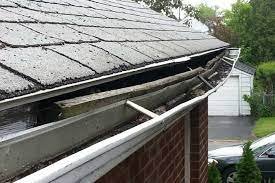
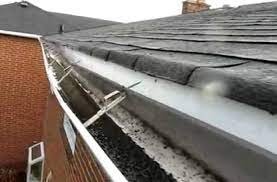
Understanding the root cause of a bent gutter is essential for repairing it effectively and preventing future issues, especially in Auckland’s challenging weather conditions.
Physical impacts are a common cause of bent gutters in Auckland. The city’s frequent storms—gusts can reach 100 km/h during winter, per MetService—often lead to falling branches or debris striking gutters, causing dents in materials like aluminum, steel, or PVC. Another frequent culprit is ladder damage. When homeowners or contractors lean ladders against gutters during roof maintenance or cleaning, the pressure can easily dent softer materials like aluminum. A West Harbour homeowner we assisted last year discovered a 15 cm dent in their gutter after a roofing job, a classic example of ladder impact that disrupted water flow during heavy rain.
Auckland’s wet climate puts significant strain on gutter systems, with the city seeing 100-150 mm of rain per month during spring and autumn, per NIWA. When debris such as leaves, twigs, or sediment accumulates, the added weight can cause gutters to sag or bend over time. This issue is particularly common in leafy suburbs like Ponsonby, Grey Lynn, and Remuera, where large trees drop debris year-round. At My Homes Construct Ltd, we’ve repaired numerous gutters in these areas where debris buildup led to bending, especially after heavy rainfall events that overwhelmed clogged systems.
Improper installation or aging materials are also major contributors to bent gutters. Gutters that weren’t installed with the correct slope (typically 1:200, per NZ Building Code) or sufficient brackets (every 600 mm) can sag under their own weight over time. In Auckland, where many homes have aluminum or steel gutters installed 20-30 years ago, age-related wear is a frequent issue—materials weaken, and rust or corrosion can exacerbate bending. PVC gutters, while more resistant to rust, can become brittle with prolonged UV exposure, making them prone to cracking or bending. A client in Mt Eden called us after noticing their 30-year-old steel gutter sagging 4 cm over a 3-meter span, a clear sign of age-related deterioration compounded by poor initial installation.
Auckland’s climate, with its temperature swings (summer highs of 25°C and winter lows of 8°C, per NIWA), can cause thermal expansion and contraction in gutter materials. Aluminum and steel expand in heat and contract in cold, which can lead to bending or warping over time, especially if the gutter wasn’t installed with expansion joints. This issue is more pronounced in Auckland’s coastal areas like Takapuna, where salt air accelerates corrosion, weakening gutters and making them more susceptible to bending.
Auckland’s unique climate presents specific challenges for gutter maintenance, making regular care and timely repairs essential for homeowners.
Auckland averages 1,200 mm of rainfall annually, with 130 rainy days per year, according to NIWA. This high rainfall puts constant pressure on gutter systems, especially during sudden downpours that can dump 50 mm of rain in a single day. If a gutter is bent or clogged, water can overflow, leading to damage to your home’s siding, foundation, or landscaping. Additionally, Auckland’s humidity—averaging 80% year-round—accelerates rust in steel gutters and encourages algae or mold growth in PVC gutters, weakening materials over time and making them more prone to bending.
Auckland experiences strong winds, particularly during winter and spring, with gusts reaching 100 km/h during storms, per MetService. These winds can dislodge branches or debris, which may strike gutters and cause dents. Coastal suburbs like Devonport and West Harbour are especially vulnerable due to their exposure to sea breezes. We’ve seen a spike in bent gutter repairs after major storms, such as the July 2024 storm that brought 120 km/h winds to the North Shore, leaving many homeowners with damaged gutter systems.
Auckland’s high UV levels, especially in summer (UV index of 10-12, per NIWA), can degrade gutter materials over time. PVC gutters become brittle and prone to cracking, while aluminum and steel can develop micro-cracks or corrosion, particularly in coastal areas where salt air is a factor. This degradation makes gutters more susceptible to bending under stress, such as during heavy rainfall or from debris buildup. Regular maintenance, like applying UV-resistant coatings to PVC gutters, can mitigate this issue.
Auckland’s native trees, like pohutukawa and kauri, shed leaves, seeds, and small branches year-round, especially during spring flowering seasons. In suburbs like Remuera and Epsom, where these trees are common, debris buildup in gutters is a constant challenge. This debris not only adds weight, causing sagging, but also traps moisture against the gutter, accelerating corrosion and bending in older systems.
Pro Tip: Install gutter guards to reduce debris buildup, especially before Auckland’s wet season (April to September). This can prevent bending and save you from frequent repairs.
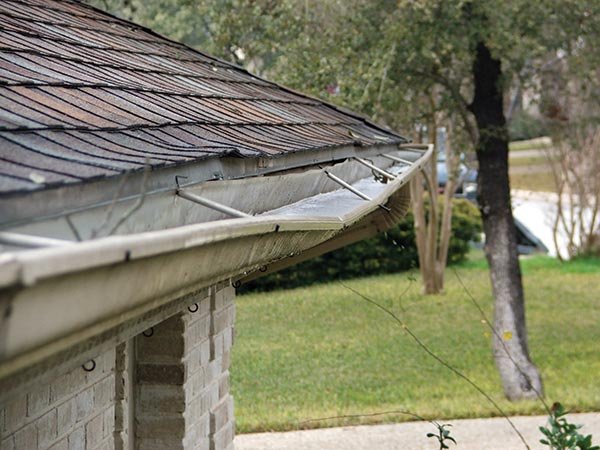
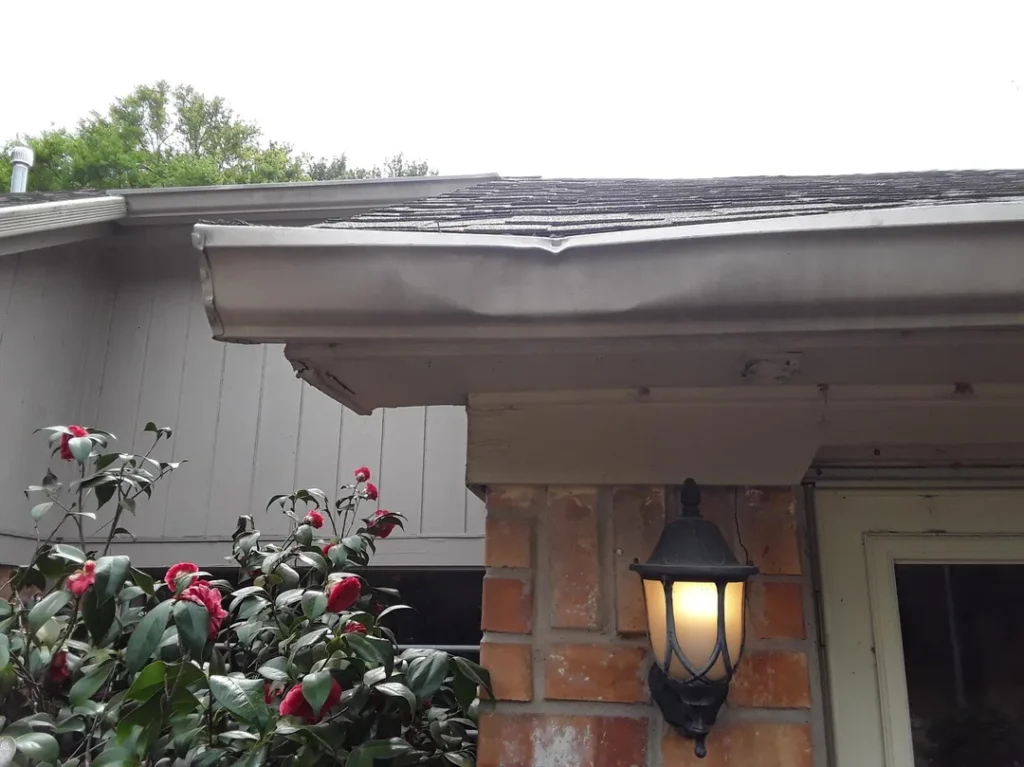
Before you begin repairing a bent gutter, gather the right tools and safety gear to ensure the job is done safely and effectively in Auckland’s often wet and windy conditions.
Safety Tip: Always check the weather forecast before starting. Auckland’s sudden showers (averaging 10 mm in 30 minutes during spring, per NIWA) can make ladders and gutters slippery, increasing the risk of falls. Avoid working during strong winds (above 40 km/h), common in coastal areas like Devonport.
Follow these detailed steps to repair a bent gutter on your Auckland home, ensuring proper water flow and preventing further damage. This process is suitable for minor to moderate dents in aluminum, steel, or PVC gutters.
Start by safely climbing your ladder to examine the bent section of your gutter. Look for:
Clear any debris around the bent area to get a better view and ensure the gutter can function properly once repaired. Use a bucket to scoop out leaves, twigs, or sediment—common in Auckland due to native trees like pohutukawa—and rinse the area with a hose. This step is crucial, as debris buildup can add weight and cause further bending. In Remuera, we helped a homeowner whose gutter was sagging due to a 5 kg buildup of wet leaves, which we cleared before repairing the dent.
With the area clear, use a rubber mallet to gently tap the bent section back into shape. Start from the edges of the dent and work inward, applying light, even pressure to avoid cracking the material. For aluminum or PVC gutters, this method works well for dents up to 5-7 cm. Steel gutters may require more force, but be cautious—steel can dent further if struck too hard. We recently helped a homeowner in West Harbour reshape a 6 cm dent in their aluminum gutter using this technique, restoring its shape in under 15 minutes without causing additional damage.
If the gutter is sagging or the dent was caused by structural weakness, reinforce it with additional brackets. Most Auckland homes use 125 mm or 150 mm half-round gutters, which should have brackets every 600 mm, per NZ Building Code standards. Use a screwdriver or drill to attach new brackets (available at Mitre 10 for $5-$10 each) to the fascia board, ensuring the gutter is level—use a level to confirm a 1:200 slope toward the downpipe. This step prevents future bending, especially during Auckland’s heavy rainfall periods, which can dump 50 mm in a single day.
After reshaping, check for small cracks or leaks that may have formed, especially in older gutters. Apply a silicone-based gutter sealant like Sika Sikaflex to these areas, smoothing it with a gloved finger for a watertight seal. Let it cure for 24 hours—important in Auckland’s humid climate, where damp conditions can slow drying (humidity averages 80%, per NIWA). We’ve used Sika Sikaflex in countless repairs across Auckland for its durability in wet environments, ensuring long-lasting results.
Finally, test the repair by running water through the gutter with a hose. Watch for proper flow—water should move smoothly toward the downpipe without pooling or overflowing. In Auckland, where sudden downpours are common, this step ensures your gutter can handle the next rain. If water still overflows, there may be an underlying issue like a misaligned slope or blocked downpipe, which might require professional help. A homeowner in Epsom we assisted tested their repaired gutter during a light rain and found it worked perfectly, preventing overflow onto their newly landscaped garden.
Pro Tip: If your gutter is near a pohutukawa tree, common in Auckland, clean it after the flowering season (December-January) to remove sticky red stamens that can clog the system and contribute to bending.
Repairing a bent gutter can be a cost-effective DIY project, but professional services may be more economical for severe damage. Here’s a breakdown for Auckland homeowners.
Pro Tip: If your DIY repair costs exceed $100 or the damage is extensive, hiring a professional may be more cost-effective, as they can address underlying issues like poor slope or corrosion that DIYers might miss.
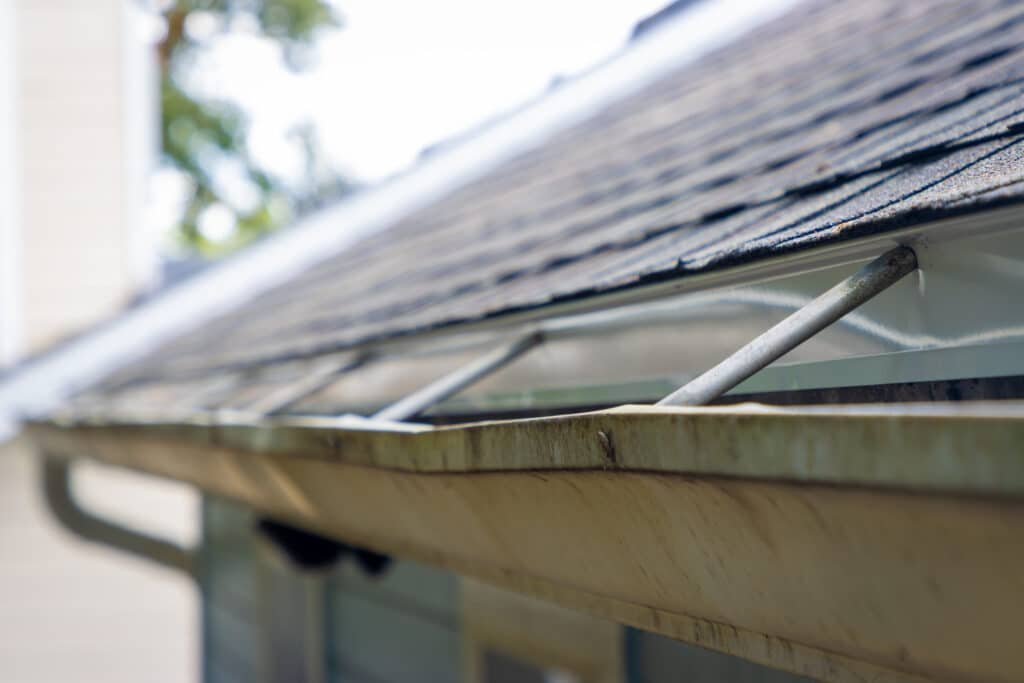
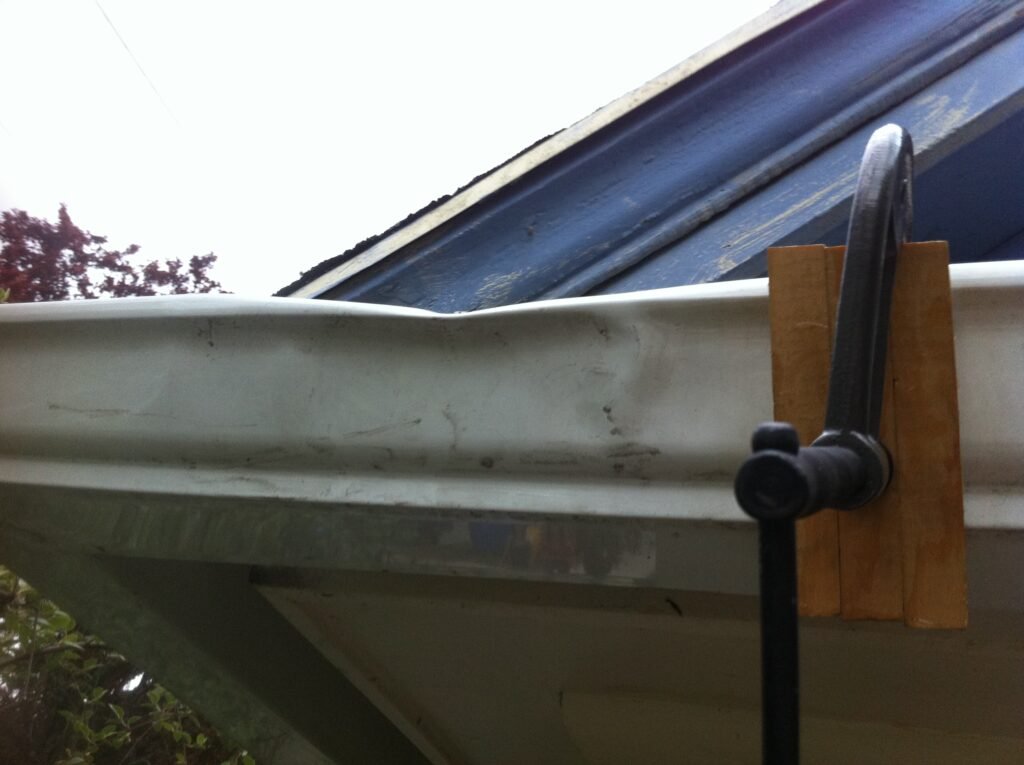
While minor dents can often be fixed DIY, some situations in Auckland require professional expertise to ensure a safe, long-lasting repair.
If the dent is larger than 10 cm or the gutter is significantly sagging (more than 2 cm over a 2-meter span), it may indicate structural damage that a DIY fix can’t address. Severe sagging often requires replacing sections or realigning the entire system, which needs specialized tools like a gutter crimper. We assisted a homeowner in Mt Roskill whose gutter had sagged 5 cm due to poor installation 20 years ago, requiring a full section replacement to restore proper water flow.
If the bent gutter has detached from the fascia or has cracked joints, it’s best to call a professional. Detached sections can lead to water spilling onto your home’s exterior, risking damage to siding or foundations—common in Auckland’s older homes in areas like Grey Lynn and Ponsonby. Cracked joints often need soldering (for steel) or replacement (for PVC), which requires expertise to ensure a watertight seal. A client in Devonport had a detached aluminum gutter section after a storm, which we reattached and sealed for $180, preventing water damage to their wooden siding.
If water still overflows after your repair, there may be an underlying issue like a blocked downpipe, incorrect slope, or hidden damage. In Auckland, where heavy rain can lead to 50 mm of rainfall in a single day, persistent overflow can cause significant damage, such as erosion around the foundation or leaks into the roof cavity. At My Homes Construct Ltd, we’ve fixed many such cases, often finding hidden blockages (e.g., sediment in downpipes) or misaligned gutters that DIYers missed, especially in two-story homes where access is tricky.
If your gutter is on a two-story home or you’re uncomfortable working at heights, a professional is the safer choice. Auckland’s windy conditions (average wind speed of 15 km/h, per NIWA) and frequent rain make ladder work risky, especially in coastal areas like West Harbour. Falls from ladders are a leading cause of injury in New Zealand, per ACC, and professionals have the right safety equipment, like harnesses and scaffolding, to work securely.
Pro Tip: If you notice rust or corrosion in steel gutters, especially in coastal areas like Takapuna, call a professional—they can assess whether replacement with a more durable material like Colorsteel is a better long-term solution.
Here are two real-world examples of gutter repairs we’ve handled in Auckland, showcasing how DIY and professional approaches can address bent gutters effectively.
A homeowner in Ponsonby noticed a 5 cm dent in their aluminum gutter after accidentally leaning a ladder against it during a roof cleaning. Following our advice, they spent $50 on tools (rubber mallet, pliers, sealant) and followed the steps above—clearing debris, reshaping the dent, and sealing a small crack. The repair took 90 minutes, and a hose test confirmed proper water flow. They saved $150 compared to a professional service and avoided overflow during a spring rain that brought 40 mm of rainfall in a day, protecting their heritage home’s wooden exterior.
A Mt Roskill homeowner contacted us after noticing their 30-year-old steel gutter sagging 5 cm over a 3-meter span, causing water to pool and overflow onto their driveway. The sagging was due to age-related corrosion and insufficient brackets, exacerbated by Auckland’s humid climate. Our team reshaped a 10 cm dent, added three new brackets to restore the slope, and replaced a rusted section for $350. The repair took 2 hours and ensured the gutter could handle the next heavy rain, preventing potential foundation damage—a common issue in Mt Roskill’s clay-heavy soil.
Prevent bent gutters and extend the life of your gutter system with these maintenance tips, tailored for Auckland’s climate and conditions.
Clean your gutters at least twice a year—before the wet season (April) and after the pohutukawa flowering season (January). This removes debris that can add weight and cause bending, especially in leafy suburbs like Epsom or Remuera. Use a bucket and hose, and wear gloves to protect your hands from sharp debris.
Gutter guards (starting at $5 per meter at Mitre 10) can reduce debris buildup, preventing sagging and bending. They’re particularly useful in Auckland, where native trees like kauri and pohutukawa shed leaves year-round. A client in Remuera installed gutter guards after we repaired their bent gutter, reducing their cleaning frequency from four times a year to once.
After major storms—common in Auckland during winter and spring—inspect your gutter brackets for looseness or damage. Tighten or replace them as needed to prevent sagging. We recommend stainless steel brackets for coastal areas like Devonport, as they resist salt-air corrosion better than standard brackets.
If you have PVC gutters, apply a UV-resistant coating (like Resene SunDefier, $30 at Resene) every 2-3 years to prevent brittleness from Auckland’s high UV levels (UV index of 10-12 in summer). This reduces the risk of cracking or bending under stress, such as during heavy rainfall or debris impact.
In Auckland’s humid climate, steel gutters are prone to rust, especially in coastal areas. Check for early signs of corrosion (small orange spots) and treat them with a rust converter (like CRC Rust Converter, $25 at Bunnings) to prevent weakening that can lead to bending. If rust is extensive, consider replacing with a more durable material like Colorsteel, which we often recommend for long-term durability.
Pro Tip: Schedule a professional gutter inspection every 5 years to catch issues like poor slope or hidden corrosion early, especially for older homes in suburbs like Grey Lynn or Mt Eden.
Here are answers to more frequently asked questions, formatted for voice search and NLP optimization.
Yes, you can fix a bent gutter without replacing it if the dent is minor (under 5-7 cm) and there’s no significant cracking or detachment. Use a rubber mallet to reshape the dent, reinforce with brackets, and seal any leaks, as outlined in our step-by-step guide. However, severe damage or extensive rust may require replacement.
A rubber mallet, adjustable pliers, a sturdy ladder, and safety gear (gloves, goggles) are essential for DIY gutter repair at home in Auckland. You’ll also need a screwdriver or drill for brackets, a silicone sealant for leaks, a level to check the slope, and a hose to test water flow. These tools are widely available at Mitre 10 or Bunnings.
If your gutter has large dents (over 10 cm), extensive rust, cracked joints, or detached sections, it may need replacing. Persistent water overflow after a repair or visible sagging (more than 2 cm over 2 meters) also indicates replacement is necessary. In Auckland’s wet climate, replacing old, corroded gutters can prevent long-term damage to your home’s foundation or siding.
Clean your gutters regularly to remove debris, install gutter guards to reduce buildup, and check brackets after storms to ensure they’re secure. For steel gutters, treat rust early with a rust converter, and for PVC gutters, apply UV-resistant coatings to prevent brittleness. In Auckland, where storms are common, these steps can significantly reduce the risk of bending.
Yes, Colorsteel gutters are a great choice for Auckland due to their durability and resistance to rust, UV damage, and salt air—ideal for coastal areas like Takapuna or Devonport. Aluminum gutters are also popular for their lightweight nature but require regular checks for dents. PVC gutters are low-maintenance but can become brittle over time, so they’re better for shaded areas.
Repairing a bent gutter is a manageable DIY project for Auckland homeowners, provided the damage is minor and you follow safe practices tailored to the city’s wet and windy climate. By understanding the causes—like storm damage, debris buildup, or aging materials—and using the right tools, you can restore your gutter’s shape and ensure proper water flow, protecting your home from Auckland’s frequent rainfall. Regular maintenance, such as cleaning before the wet season and installing gutter guards, can prevent future bending, while knowing when to call a professional ensures severe issues are handled safely and effectively.
My Homes Construct Ltd is here to help with all your gutter repair needs.
📞 Call us at +64 22 315 8987 – Auckland’s trusted gutter repair experts.
📍 Visit us at 84B West Harbour Drive, West Harbour, Auckland
WhatsApp us